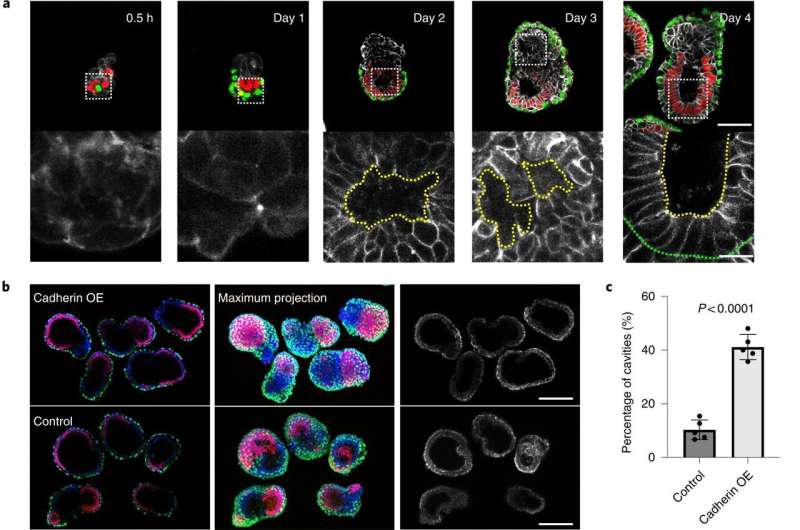Correct self-organization is necessary for proper morphogenesis. a, Time course of the assembly of ETX embryos stained to reveal E-cadherin (monochrome), Oct4 (red) and Gata4 (green). The bottom row of images are magnifications of the images above and show E-cadherin staining around a nascent cavity, as indicated by the dashed yellow lines. The dashed green line indicates the boundary between the ES and XEN compartment. Scale bar, 5 μm. b, Representative images showing Oct4 (red), Gata4 (green), E-cadherin (monochrome) and DAPI (gray) staining in day 4 cadherin OE ETX structures formed by combining E-cadherin OE ES cells with P-cadherin OE TS cells and wild-type XEN cells. ETX structures formed by combining wild-type cells were used as a control. Scale bars, 100 μm. c, Comparison and quantification of joined cavity formation in cadherin OE and control ETX structures. n = 361 (control group) and n = 253 (cadherin OE group). N = 5 for each condition. The data are presented as means ± s.d. Statistical significance was determined by unpaired two-tailed Student’s t-test. d, Representative image showing Oct4 (red), Gata4 (green), laminin (monochrome) and DAPI (blue) staining in day 4 cadherin OE ETX structures formed by combining E-cadherin OE ES cells with P-cadherin OE TS cells and wild-type XEN cells. ETX structures formed by combining wild-type cells were used as a control. Scale bars, 100 μm. e, Quantification of the structures that contained continuous or discontinuous laminin. n = 40 ETX structures per condition. N = 3. The data are presented as means ± s.d. Statistical significance was determined by unpaired two-tailed Student’s t-test. f, Self-organization principles in stem cell-derived ETX embryos. Differential expression of E-, K- and P-cadherins enables the sorting of ES (epiblast-like), XEN (VE-like) and TS (TE-like) stem cells. Wild-type ES cells with low E-cadherin expression and wild-type TS cells with low P-cadherin expression exhibited detrimental global sorting efficiency. This could be overcome by overexpressing E-cadherin in ES cells and P-cadherin in TS cells to increase the efficiency of ETX embryo formation. Proper morphogenesis, including cavity formation, basement membrane formation (purple) and symmetry breaking can only be observed in well-sorted structures. Numerical data are available as source data. Credit: Nature Cell Biology (2022). DOI: 10.1038/s41556-022-00984-y
A team of researchers at the California Institute of Technology, working with one colleague from The Francis Crick Institute and another from the University of Cambridge, both in the U.K., has developed a way to grow mouse embryos without using mouse eggs or sperm to learn more about early mammalian development. In their paper published in the journal Nature Cell Biology, the group describes using several types of stem cells to grow mouse embryos.
Prior research has shown that mammalian embryos differentiate into different types of cell masses as they develop. Researchers have also found that stem cells are involved in the processes but the mechanisms responsible are still unknown. In this new effort, the researchers used three different kinds of stem cells to grow a mouse embryo that matured to the point of having a beating heart and the beginnings of a brain.
To create such embryos, the researchers first studied communications between stem cell groups in naturally developing mouse embryos. They learned to recognize the elements that went into such communications and the means by which it was carried out. In essence, they "deciphered the code." They then isolated three main types of stem cells that made up the cell masses in early embryo development: pluripotent, which eventually grow to become body tissue, and two other types that grew to become the amnionic sac and placenta. They also noted the quantities of each type of stem cell.
The next step was to attempt to create a mouse embryo from scratch using the three types of stem cells in a lab setting. With careful tending, the researchers grew an embryo that matured enough to allow for study of its development.
To test further, the researchers repeated the procedure but added genetically engineered cells to see how it impacted maturation of the embryo. They found they could replicate some of the same brain development issues that have been seen in human embryos. They suggest their work could also help explain what goes wrong when mice (or people) miscarry.
More information: Min Bao et al, Stem cell-derived synthetic embryos self-assemble by exploiting cadherin codes and cortical tension, Nature Cell Biology (2022). DOI: 10.1038/s41556-022-00984-y
Journal information: Nature Cell Biology
© 2022 Science X Network
























